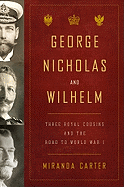
 Queen Victoria of Great Britain assumed the role of "matriarch of royal Europe" during her long reign (1837–1901) by force of personality (bossy, with her nose in everyone's business) and by tirelessly arranging her children's marriages to cement alliances among ruling families. As Miranda Carter (Anthony Blunt: His Lives) points out in this masterful history of Europe before World War I, sooner or later Victoria became every dynasty's grandmother.
Queen Victoria of Great Britain assumed the role of "matriarch of royal Europe" during her long reign (1837–1901) by force of personality (bossy, with her nose in everyone's business) and by tirelessly arranging her children's marriages to cement alliances among ruling families. As Miranda Carter (Anthony Blunt: His Lives) points out in this masterful history of Europe before World War I, sooner or later Victoria became every dynasty's grandmother.
The generation of Victoria's grandchildren would, however, prove a disappointment in continuing her grand plan to have her descendants control Europe. She would not have been pleased. George of Great Britain, Nicholas of Russia and Wilhelm of Germany were raised oddly and haphazardly, inadequately educated and isolated from the real world. Carter recounts example after example of how unqualified these three were for their dynastic functions, even if the age had been less challenging; in one of the most telling ones, Tsar Alexander III dismisses a suggestion that he give his heir Nicholas more substantive responsibilities (at age 23) by saying, "He's nothing more than a child. His judgment is infantile." When your father the tsar is unwilling to develop your abilities, what can the future hold?
Victoria's first and favorite grandchild was Wilhelm (later Kaiser Wilhelm II of Germany). As kaiser, he cultivated Victoria's central conceit that "diplomacy should be conducted through personal relationships between monarchs"--except, of course, nobody ever considered his bullying methods to be in the least diplomatic. Alexandra of Hesse-Darmstadt was Victoria's favorite granddaughter. She would marry Nicholas of Russia and go down in history as his doomed, jewel-encrusted tsarina. Beloved by Queen Victoria as children, Wilhelm and Alexandra endeared very few as adults. Alexandra would manage, largely by her own doing, to become the most hated woman in Russia; the more ambitious Wilhelm succeeded in being the world's most hated man in his time.
The family trees for the Hohenzollerns, the British Royal Family (the Saxe-Coburg-Gothas, renamed the Windsors), the Danish Royal Family (the Glucksburgs) and the Romanovs are dauntingly labyrinthine, yet Carter makes the connections, competition and tensions among dynasties remarkably clear as she charts the breakdown of Europe and its march toward a devastating war. Victoria's grandchildren had played their royal parts in the years of rampant rumor, suspicion, denial, incompetence, posturing and intrigue that climaxed in this war; those who survived the war spent the rest of their lives blaming others and characteristically avoiding all responsibility.--John McFarland
Shelf Talker: A clear, commanding and highly readable history of the last gasps of dynastic Europe before World War I--with its casualties of 8.5 million soldiers killed and 21 million wounded.

